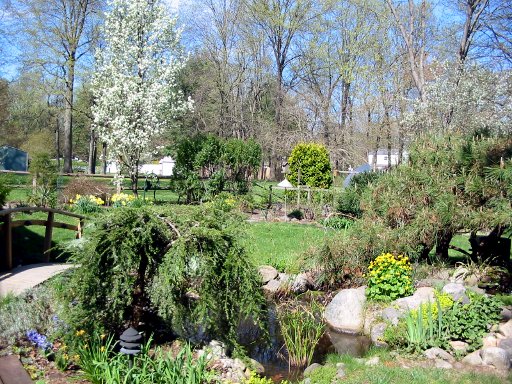
Ahh, Springtime! A beautiful morning in early April. All the snow is gone, and the pear tree and daffodils are in bloom!
Our last update ended with a stack of wooden boxes in the basement, didn't it? Well, it's about time we did something with them!
But first, a little background story might help.
I had been reading about honeybees dying from Colony collapse disorder for a year or so. And every time I read one of those stories, it made me feel uneasy. I felt like I should do something. We also have so many flowers and a couple fruit trees in our yard that depend on bees and other insects for pollination.
In late 2008, after reading another one of those newspaper articles, this thought came to me: "I wonder what's involved in becoming a beekeeper?"
So that evening, I started googling about bees and beekeeping. Eventually, I stumbled across this article that mentioned Rutgers University offered a hands-on 3-day Beekeeping class! So I signed up for the May 2009 session, if only to learn more about honeybees.
The class turned out to be both fascinating and inspiring. It was taught by Bob Hughes (with 25 years beekeeping experience) and Tim Schuler, the New Jersey State Apiarist. It consisted of both classroom learning and hands-on training. I took my youngest son with me on the last day, where he raised his hand and volunteered to cut the wax caps to release honey from the comb. He was good at it... and so it seemed I would have a helper (and honey salesman) if we wanted to try having an apiary! They did mention that one requirement for hive placement was that there be water available within 50 feet... oh, did I mention we had a pond in the back yard?! Anyway, I came out of the class thinking "We could do this!"
So in the Fall of 2009, I ordered all the necessary equipment, mostly from the good folks at Brushy Mountain Bee Farm. Later, when my in-laws came to visit, my Father-in-law assembled and painted the hives for me. And that's where we left off last year...

Ahh, Springtime! A beautiful morning in early April.
All the snow is gone, and the pear tree and daffodils are in bloom!
Sadly though, we lost 4 fish this Spring... all the colorful Comets disappeared. A Great Blue Heron had found our pond! The 2 big Koi survived, and the darker-colored baby fish managed to escape as well (obviously a good color for hiding in there). We picked up a few new Comets and put up a small fence to keep the heron at bay. So far, so good... but we're keeping an eye out for that bird!
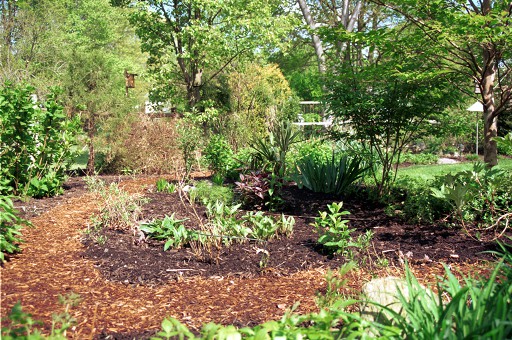
Every other year, we distribute 10 cubic yards of mulch over
the landscaped area. That was this year! The path
consists of cedar wood chips (with newspaper underneath)
and makes the whole space accessible. In the shade,
you can make out the silhouette of the Needle Palm we bought
last year. It survived the Winter wrapped in burlap and is
starting to grow.
And now... it's time for the HONEYBEES!
In March, I ordered a "package" of Italian honeybees from the friendly people at Draper's Super Bee Apiaries. And then I waited...

Then on May 20th at 4:30 PM, I got a call from the main post office in
central New Jersey. The guy said "your bees are here, do you want
to come get them?!" I said "Yes! I'm on my way now!" and ran out the door.
However, when I got to the (huge) post office,
the guy at the counter asked "do you know who called you?" I said "uh, no."
So for the next 10 minutes or so, they searched for my bee package.
Finally the guy in charge came out and exclaimed, "We found them!
Just drive around back past the gate to the loading dock."
...and yes, there they were!!
This is a 3-pound package of "Gentle Italian Honey Bees," consisting of 10,000 honeybees and one queen (in a tiny cage). There is also a canister of food in there (as it was long a 4-day journey from Georgia). The spray bottle on the right contains sugar water. We sprayed this over the bees in the cage several times to calm them down. They lick the sugar water off each other for nourishment.
According to the instructions, we're supposed to put the bees into the hive at dusk, so that was the plan for tonight!
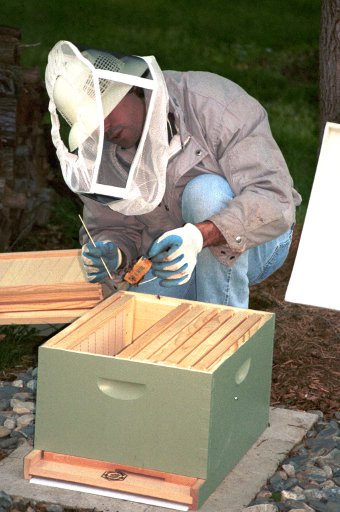
The first step is to remove the small "queen cage" from
the package and put it into the hive.
The queen is trapped in this cage by a piece of candy and the worker
bees have to eat through the candy to release her (which generally
takes a couple days). This is necessary because the worker bees
have to get used to their queen.
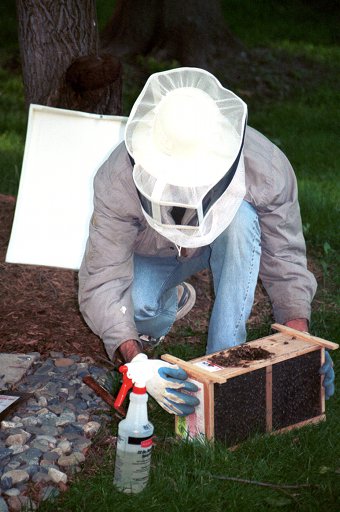
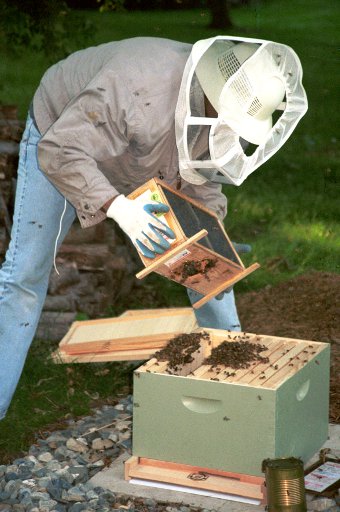
And now the real fun begins... get this!
You're supposed to shake the rest of the bees out of the
box and into the hive!! Can you imagine?? Yeah, just dump them
right into the hive. Oh, then bang on the box a couple times to
shift the remaining bees to one side and pour out another clump of bees!
Repeat this process a few times until most of the bees are out, and then
carefully slide the wax foundations back into the hive without
squishing the bees. It was quite an experience!
The reason this works is, the bees in the package do not have a home yet so they have nothing to defend! They have no reason to be aggressive, so they just fall right into the hive and start mulling about.
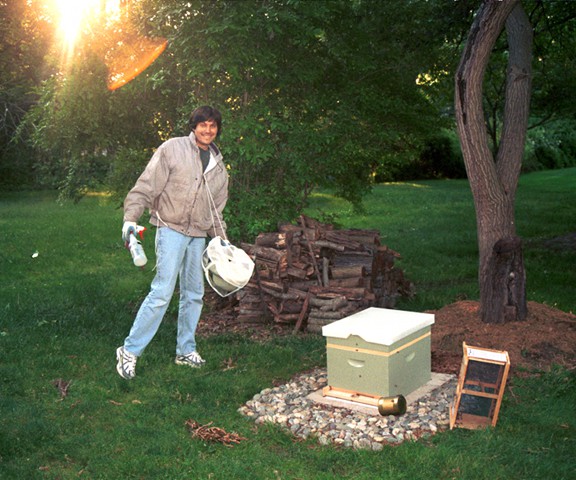
After that, close up the hive and you're done!
You can see above the hive body I am using a "Hive Top Feeder." In here, we will continue to pour sugar water twice daily, for at least the first month or so. This gives the bees nourishment until they find their own sources of food. Catarina is in charge of making all the "bee juice!"
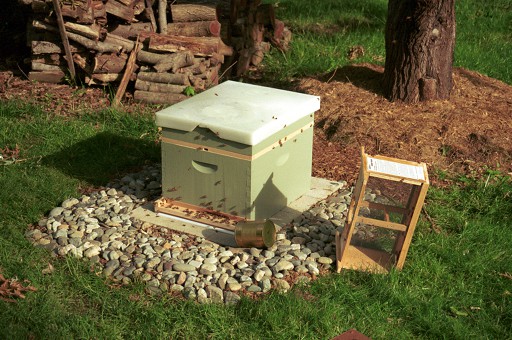
The next morning, the bees were out doing their practice flights.
They very quickly learn the surrounding area and will travel in a 4 mile
radius from the hive to collect nectar and pollen.
I left the package container next to the hive overnight so that the
remaining bees would clear out into their new home.
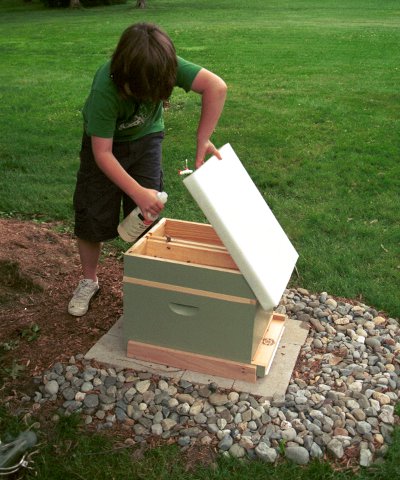
Here's my youngest son feeding them "bee juice." They dont seem
to mind when you open the top cover to feed them; as a result, we usually
don't bother smoking the hive or wear the bee hat for this task.
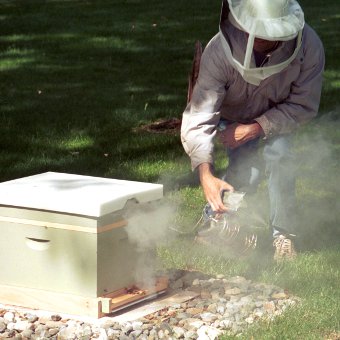
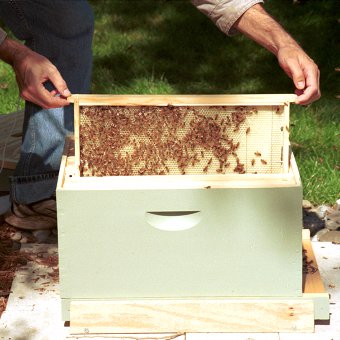
Now it's time for our 1-week checkup! We have not opened/disturbed
the hive since we installed the package. After the first week, we have
to open the hive and check that (1) the queen has been released, and
(2) the worker bees are constructing comb.
For this operation, I will use the smoker! Since we have a Pine tree in the yard, we fill it with dry pine needles.
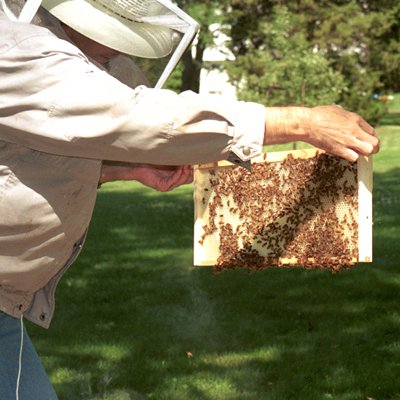
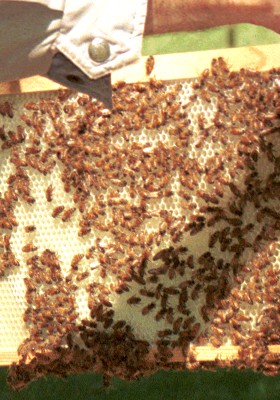
Can you see the honeycomb? In the close-up, you can see that the bees
are building out hexagon-shaped cells. In these wax-cells,
they will store pollen, make honey, and raise their young.
We also spotted the queen roaming about free from her cage so
that was good! I had them put a blue paint dot on the back
of the queen so I could more easily find her.
The following week, we did another hive inspection and found pearly white u-shaped brood in the comb. Those are the baby bees! In the Summer, honeybees generally only live for a month or so.
Oh, and no one here has been stung yet!! :-)
If all the insects on earth disappeared,
within 50 years all life on earth would disappear.
If all humans disappeared,
within 50 years all species would flourish as never before.
-Jonas Salk
previous
next

